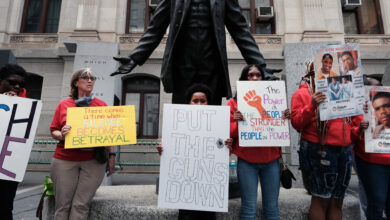Inflation vs. Recession: The Fed Is Walking a Tightrope

Even before Russia invaded Ukraine, the Federal Reserve was in a tough spot.
Now it has embarked on a precarious balancing act, trying to rein in high inflation while simultaneously avoiding a severe economic slowdown, perhaps even a recession.
The Fed announced Thursday that it would start raising interest rates for the first time since 2018, and the initial reaction of financial markets was welcoming. The stock market rose, bond yields wavered and commodity prices moderated.
But whether the economy can withstand rising rates during a period of geopolitical turmoil and a lingering pandemic is a question without an immediate answer.
“Certainly inflation is very high, and the recession risk is a lot higher today than it was 12 months ago — there’s no doubt about that,” said James Paulsen, chief investment strategist for the Leuthold Group, an independent stock research firm in Minneapolis. “But I think there’s a fairly good chance that we’ll have a soft landing.”
That’s not a unanimous position among market strategists, however.
“I think the recession risk is very high,” said David Rosenberg, chief economist of his own firm, Rosenberg Research, in Toronto. “The Fed is caught in a box of its own making because it didn’t move quickly enough on raising rates. Now it has to be seen to move aggressively.”
The Fed’s language was strikingly forceful. “Inflation remains elevated, reflecting supply and demand imbalances related to the pandemic, higher energy prices and broader price pressures,” it said. “The invasion of Ukraine by Russia is causing tremendous human and economic hardship.”
But its actions, so far, have been mild. It began its mission gingerly, raising its benchmark interest rate, the federal funds rate, just 0.25 percentage points.
That’s just the beginning.
The central bank indicated that this increase is likely to be just the first of seven this year, a major shift in direction. The Fed funds rate has been near zero since March 2020 — a level intended to pull the economy out of the recession touched off by the coronavirus pandemic that month.
In addition, Jerome H. Powell, the Fed chair, said in a news conference on Wednesday that the Fed could begin in May to reverse the grand experiment known as quantitative easing, which swelled its balance sheet to a gargantuan $8.9 trillion and helped spur the recovery from the pandemic.
Using unusually candid language in response to a reporter’s questions, Mr. Powell said the Fed “obviously” should have begun tightening rates earlier, before inflation got so high. What’s more, the Federal Open Market Committee, the Fed body that sets policy, acknowledged what financial markets and federal statistics had been saying for months: Inflation is uncomfortably elevated, and likely to remain so for some time.
In a statement on Wednesday, the committee said it expected inflation to remain well above its target of 2 percent through at least 2023.
“Inflation is likely to take longer to return to our price stability goal than previously expected,” Mr. Powell said.
On the other hand, he said, Russia’s war in Ukraine is not only adding to inflation by raising the prices of crucial commodities like oil and wheat, it is increasing the uncertainty in the economic outlook. Yet Mr. Powell maintained that the economy remained strong and that this was a good time to prevent the “entrenchment” of runaway inflation.
Russia, supply chains and an oil shock
That may well be the case. The unemployment rate, just 3.8 percent in February, is extremely low, and inflation, 7.9 percent for the 12 months through February as measured by the Consumer Price Index, is as high as it has been since the 1980s.
Under these circumstances, it would be hard to argue that the Fed should do nothing about the current inflation readings.
Yet the geopolitical situation is fraught with danger.
Oil prices have dipped from peaks they reached only last week, but shortfalls in the oil supply and rising prices induced by the war — including Western sanctions against Russia — remain a serious threat to the economy.
In an interview, James D. Hamilton, professor of economics at the University of California, San Diego, and a leading expert on the economic effects of oil shocks, said they had “made major contributions to recessions over many decades.” At current oil price and supply levels, the effects of the Russian war “are fairly manageable for the American economy.”
But Professor Hamilton pointed out that Russia’s oil, which amounts to about 10 percent of world production, could not be easily replaced if totally cut off — an outcome that he does not believe to be likely. Nonetheless, even the loss of a substantial part of it could constitute an oil price shock rivaling those of the 1970s, he said.
Furthermore, cuts in the availability of Russian commodities like palladium, which is important for the catalytic converters in gasoline-fueled cars, and nickel, which is used in car batteries and for many other purposes, also amount to supply shocks.
How serious is the danger that these war-related issues will cause major economic problems in the United States? “We’ll have to be looking at this carefully,” Professor Hamilton said.
Omicron in China
Another variable for the Fed to consider: The global supply chain problems that have contributed to inflation in the United States could be made much worse by the worst outbreak of Covid-19 in China since early 2020. Lockdowns and restrictions in China are already slowing the supply of products like Toyota and Volkswagen cars and Apple iPhones, as well as components such as circuit boards and computer cables, as Keith Bradsher reported for The New York Times from Beijing.
“The situation in China definitely complicates things for the Fed,” said Yung-Yu Ma, chief investment strategist for BMO Wealth Management in the United States. “It adds a level of delicacy to the mix here, and one that’s very hard to predict.
“It was already a challenging environment before this,” he added. “Remember, in the markets, we began in the good old days in January just worrying about what the Fed would do about interest rates.”
The experimental Fed
All things being equal, at a moment like this it might be judicious for the Federal Reserve and other central banks to prepare a full array of monetary tools and issue comforting statements indicating that they are ready to bolster the economy wherever and whenever needed. Mr. Powell did say that the rate tightening would be “data driven” and that the central bank fully intended to support a strong economy. But he stressed unmistakably that the Fed’s immediate focus was on curbing inflation.
With decent luck, it will be able to bring the rate of price increases down to more palatable levels gradually without needing to raise interest rates high enough to set off a recession.
But as Kathy Jones, chief fixed-income strategist with the Schwab Center for Financial Research, pointed out, many people in the markets are not entirely convinced. “What a bundle of contradictions,” she said on Twitter. “Raise rates a bunch, bring inflation down but GDP growth and unemployment are steady. Hmmm.”
The Fed’s long and innovative experiments in monetary policy are far from over.
Its latest announcements put the central bank on a narrow path that may turn out to be less a straightforward march toward its goals of price stability and maximum employment than a tightrope walk. In the meantime, the coronavirus, Russia’s war, supply-chain disruptions and soaring prices threaten to upset its delicate balance.
.





